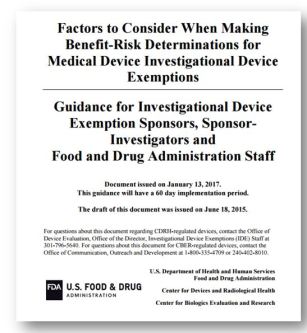FDA BRIEF: Week of January 9, 2017


OVERVIEW: >100 documents, list reflects draft and revised draft guidances under development at the time of this release
CATEGORIES: Advertising, Biopharmaceutics, Biosimilarity, Clinical/Antimicrobial, Clinical/Medical, Clinical Pharmacology, Clinical/Statistical, Drug Safety, Electronic Submissions, Generics, Labeling, Pharmaceutical Quality/CMC, Pharmaceutical Quality/Manufacturing Standards, Pharmacology/Toxicology, Procedural, User Fee

OVERVIEW: Problems with analysis and interpretation of results of study with multiple endpoints & management of problems of false conclusions if no adjustment for multiplicity
GENERAL PRINCIPLES:
- Hierarchy of Families of Endpoints
- Type II Error Rate and Multiple Endpoints.
- Types of Multiple Endpoints.
- Individual Components of Composite and Other Multi-Component Endpoints
STATISTICAL METHODS:
- Type I Error Rate for a Family of Endpoints and Conclusions on Individual Endpoints
- When the Type I Error Rate Is Not Inflated or When the Multiplicity Problem Is Addressed Without Statistical Adjustment or by Other Methods
- Common Statistical Methods for Addressing Multiple Endpoint-Related Multiplicity Problems

OVERVIEW: Clarity regarding principal factors that FDA considers when assessing the benefits and risks of IDE applications for human clinical studies; to run trials in an efficient and cost-effective manner, while maintaining appropriate patient and research participant protections
SCOPE:
- Informed Consent and IDE decisions
- IDE application assessment in the context of device development pathway
- Assessing benefits and risks for IDE applications
- Recommended General Framework for benefit-risk assessment
- Hypothetical examples of summary benefit-risk assessment
- Reference guide
- Risk management terms